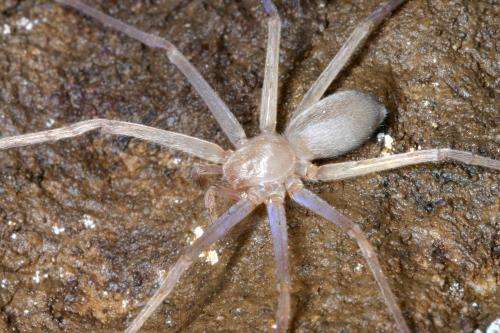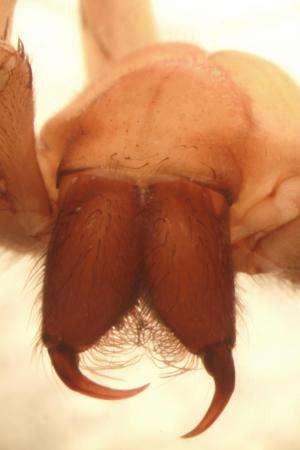The eyeless huntsman spider © Senckenberg
A scientist from the Senckenberg Research Institute in Frankfurt has discovered the first eyeless huntsman spider in the world. The accompanying study has been published by the scientific journal Zootaxa.
With a leg span of only six centimetres and a body size of around twelve millimetres, the spider Sinopoda scurion is certainly not one of the largest representatives of the huntsman spiders, which include more than 1100 species. However, it is the first of its kind in the world without any eyes.
“I found the spider in a cave in Laos, around 100 kilometres away from the famous Xe Bang Fai cave,” reports Peter Jäger, head of the arachnology section at the Senckenberg Research Institute in Frankfurt. “We already knew of spiders of this genus from other caves, but they always had eyes and complete pigmentation. Sinopoda scurion is the first huntsman spider without eyes.”
The regression of the eyes is attributable to living permanently without daylight. This adaptation was also observed in other cave-dwelling spider species by the Frankfurt arachnologist. “The Sinopoda species described demonstrate all kinds of transitions to cave adaptation – from eight functioning eyes to forms with six, four and two lenses, right up to blind spiders,” explains Jäger.
Front view of Sinopoda scurion. The spider’s eyes are completely missing. © Senckenberg
The spiders are in good company: fish, scorpions and crabs that have adapted to caves have already been found in the caves of Laos.
In total, the Frankfurt spider researchers have described nine new species of the genus Sinopoda. The fact that all of the species have been found in caves confirms the animals’ preference for underground habitats. Because of the small-scale area in which the spider species can be found it is possible to study their adjustment to the cave as a dwelling – the number of eyes present and the visual faculty may possibly shed light on the time of settlement. “Furthermore, the spiders can be used as indicators for the threat to their habitats. These are often endangered by tourism or the exploitation of the limestone rocks to make cement,” says Jäger.
The eyeless huntsman spider was named after the Swiss company “Scurion” that makes headlamps for caves (www.scurion.ch). “Sinopoda scurion is the first species that I have named after a company in the context of the Patrons for Biodiversity programme,” explains Jäger. “The headlamps by Scurion help me to illuminate the darkest corners on my cave trips, and thus recognise hazards such as poisonous snakes and scorpions, but also discover very small organisms.”
Journal information: Zootaxa
Provided by Senckenberg Research Institute
























